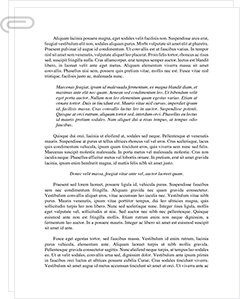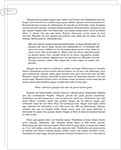 Study Document
Study Document
Leadership of Small Medium Enterprises Literature Review
Pages:4 (1204 words)
Sources:1+
Subject:Business
Topic:Leadership Development
Document Type:Literature Review
Document:#13148212
The SMEs are competitive in Russia, but many under developments are causing a lag in the developments of the companies. There are many inconsistencies in the leadership, but other factors also discourage the improvement of the small companies. These issues include lack of resources in Russia, and also lack of capabilities. The development in infrastructure has proven to be slow and also lack of equipment. Many companies are waiving from the Russian market mainly because of the complexities and also the issue of transition economies.
SMEs are not taking advantage of strategies that will elevate them to economy driven positions. The SMEs are not taking the right measures to establish business relation. The SMEs have to commit themselves in the market, it terms of investing, acquire the best personnel and realize their potential through time management. Modes of success have to be analyzed and adopted through joint ventures, engaging in sales and distribution, getting the best contracts in the market and being in control (Albertini, 2011).
Research questions
When coming up with the research questions, the emphasis of the questions was on leadership for SMEs. The most relevant question would be "Is leadership the main factor slowing down development in SMEs?" The question focuses on the factors of leadership, and the best manner to manage small enterprises so as to expand them and stabilize the economy. The query's relevance is vital as it would assist to explain the outcome of effective leadership in SMEs. The question, therefore, analyzes and interprets market realities and also the aspects of free-market ideologies.
Definition of key words
The key word popularly evident in this article is Small and Medium Enterprises (SMEs). They are companies whose number of workers and employees and turnover hardly pass a certain criteria. Companies with less than nine employees would be considered to be micro-firms due to the limited number of employees. For a firm to be called a small firm it has to have up to 49 employees. Companies with a range of 50-249 employees would be known as a medium firm. Large firms are those with over 250 employees. This data was gotten from the department for business, enterprise and regulatory reform (BERR). SMEs have to make certain that they match up to the regulatory provisions (Levchenko, 2008).
Contribution of research to the Literature
The research undertaken while assessing the situation of SMEs will directly affect the literature in question. The line of argument is whether leadership theory changes can have an impact on development of SMEs. Factual points representing this assertion depict that Russia's economy could improve if it adopted the best management personnel. Managers will assist the SMEs to develop into bigger firms through making the right decisions, integrating other development strategies such as market penetration, product development and many other strategies.
References
Albertini, F. (2011). Entry Strategy for SMEs in the Russian Market. School of Business and Economy. 8(2), 3-5.
Analovi, F. & Karami, a. (2003). Strategic management in small and medium enterprises. New York: Cengage Learning EMEA.
Bolden, R. (2001). Leadership Development in Small and Medium sized Enterprises. Retrieved October 11, 2012 from http://centres.exeter.ac.uk/cls/documents/SME2.pdf
Dallago, B. (2012). Small and Medium Enterprises in Central and Eastern Europe. University of Trento, Tokyo. Retrieved October 11, 2012 from http://src-h.slav.hokudai.ac.jp/pdf_seminar/031210smes_3.pdf
Levchenko, M. (2008). EU-Russia Cooperation Mutual Benefits for SMEs in Framework Programs. Retrieved October 11, 2012 from http://publications.theseus.fi/bitstream/handle/10024/17568/jamk_1212141105_2.pdf?sequence=2
McIntyre, R. (2001). The Role of SMEs in Transition: Growth and Entrepreneurship. Retrieved October 11, 2012 from http://www.wider.unu.edu/publications/working-papers/previous/en_GB/rfa-49/_files/82530864978209474/default/rfa49.pdf
Sample Source(s) Used
References
Albertini, F. (2011). Entry Strategy for SMEs in the Russian Market. School of Business and Economy. 8(2), 3-5.
Analovi, F. & Karami, a. (2003). Strategic management in small and medium enterprises. New York: Cengage Learning EMEA.
Bolden, R. (2001). Leadership Development in Small and Medium sized Enterprises. Retrieved October 11, 2012 from http://centres.exeter.ac.uk/cls/documents/SME2.pdf
Dallago, B. (2012). Small and Medium Enterprises in Central and Eastern Europe. University of Trento, Tokyo. Retrieved October 11, 2012 from http://src-h.slav.hokudai.ac.jp/pdf_seminar/031210smes_3.pdf
Related Documents
 Study Document
Study Document
Small Medium Enterprise Setup Financial and Market Analysis
Small Medium Enterprise Set Up Mission statement Business goals Marketing Market research (location and size of market) Market segmentation (which segments will you target) Marketing plan Products/services and target market(s) Placement Promotions and advertising Pricing policy Evaluation of marketing Operations Legal and licensing requirements Organisational structure and staffing Insurance and security issues Business premises Equipment required Production process Critical risks/contingency plans Financial projections Capital expenditure forecast Sales forecast Cash flow forecast Projected profit and loss statement Owner's personal expenses (continued on next page) Environmental responsibility and Eco-sustainability Implementation timetable Conclusions and future directions Executive Summary Business Plan Structure The business plan
 Study Document
Study Document
Leadership SME Leadership Strategy From the Top
Leadership SME Leadership Strategy from the Top Down: Lessons from the Boardroom in Small and Medium Enterprises Leadership and management theories and strategies have proliferated at a rapid rate in the twentieth and twenty-first centuries, as organizations have grown larger and more complex and have faced pressures of a much faster pace of business. The demands made on leaders of business organizations and the need for strong leadership in navigating the ever-more
 Study Document
Study Document
Leadership Priorities and Practice in Organizational Management
Leadership Priorities and Practice in Organizational Management The enterprise software industry is going through a series of disruptive innovations that are disrupting the economics of the industry while also shifting the balance of power away from the Chief Information Officer (CIO) to the line-of-business leaders including the Vice Presidents, General Managers and Directors of Business Units. As this balance of power shifts throughout enterprise software, many long-standing approaches to developing, delivering,
 Study Document
Study Document
Leadership Strategies for Virtual Teams
Leadership Development in Al Kerak Court: Navigating the Challenges of Remote Human Resources ManagementAbstractIn the field of Human Resources Management, Al Kerak Court represents a pioneering entity of the virtual corporate domain. As such, it faces significant challenges that hinder its leadership development and operational efficiency. This paper examines the aspects of remote HR management at Al Kerak Court, with a focus on the triad of issues that undermine its
 Study Document
Study Document
Leadership Theory in a Changing and Globalizing
Leadership Theory in a Changing and Globalizing Marketplace Modern business practice is permeated by the complexities of a changing world. The impact of globalization on the cultural makeup of companies, the effects of the global recession on the conventions of daily business and the evolutionary shifts brought on by emergent technology all call for an orientation toward simultaneous stability and adaptability. Only under the stewardship of a qualified, communicative, flexible and
 Study Document
Study Document
Leadership Styles Among Male and Female Principal and How Teachers Rate Their Principals...
Leadership Styles Among Male and Female Principal It is the intention of this research to study the leadership and cognitive styles of teachers and instructors of both genders within the educational system and their preference for types of leadership in a principal of that institution. The research will include teachers and educators from all levels of the educational system from grade school to high school. The study will also include teachers and



